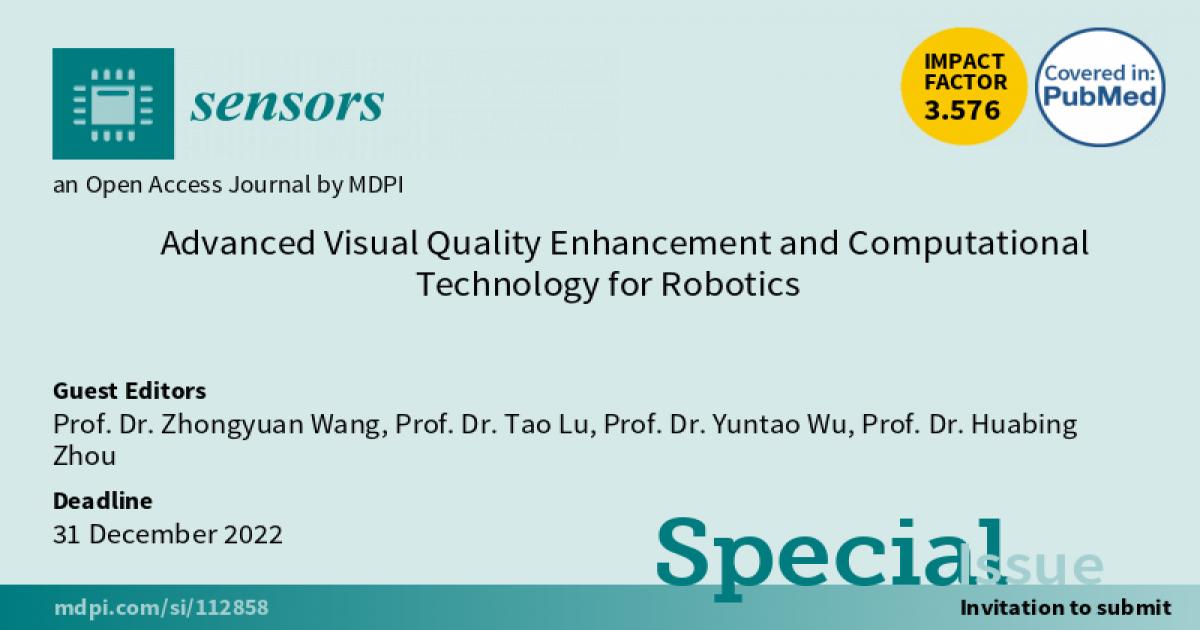Advanced Visual Quality Enhancement and Computational Technology for Robotics
A special issue of Sensors (ISSN 1424-8220). This special issue belongs to the section "Sensing and Imaging".
Deadline for manuscript submissions: closed (31 December 2022) | Viewed by 21554

Special Issue Editors
Interests: video compression; image processing; multimedia communications
Interests: computer vision;image processing; multimedia communications
Interests: Intelligent information processing; intelligent computing; wireless sensor network technology
Special Issue Information
Dear Colleagues,
Computer vision provides the key perception and computational approach of unmanned systems such as robots, intelligent video surveillance, and so on. Although advanced sensors can accquiire clearer images and videos, suffering from the limitations of hardware equipments and environmental factors, in many cases, only low-quality images and videos are available, which poses a huge obstacle to computer vision based applications. Video image quality enhancement is an old task, but with the blessing of current deep learning, it also has more promising prospects. For instance, significant improvements in image/video restoration and enhancement tasks such as super-resolution, denoising, deblurring, and deraining can recover information lost due to sensor hardware limitations. In the meantime, substantial progress has also been made in high-level vision fields such as recognition, idenification, authentication, and abnormality diagnosis, etc. Especially, this Special Issue encourages robotics related innovative studeis, not only in low-level vision, but also in modeling, analysis and understanding driven by visual quality. In addition, AI-synthesized digital content also brings confusion and challenges to real-world sensory information. Therefore, valuable research refers not only to recovering low-quality videos/images, but also to credibly distinguishing real-world contents from AI-generated contents.
For the better utility of images and videos acquired from sensors, this Special Issue aims at exploring novel image/video restoration and understanding methods using deep learning and other approaches.
Prof. Dr. Zhongyuan Wang
Prof. Dr. Tao Lu
Prof. Dr. Yuntao Wu
Prof. Dr. Huabing Zhou
Guest Editors
Manuscript Submission Information
Manuscripts should be submitted online at www.mdpi.com by registering and logging in to this website. Once you are registered, click here to go to the submission form. Manuscripts can be submitted until the deadline. All submissions that pass pre-check are peer-reviewed. Accepted papers will be published continuously in the journal (as soon as accepted) and will be listed together on the special issue website. Research articles, review articles as well as short communications are invited. For planned papers, a title and short abstract (about 100 words) can be sent to the Editorial Office for announcement on this website.
Submitted manuscripts should not have been published previously, nor be under consideration for publication elsewhere (except conference proceedings papers). All manuscripts are thoroughly refereed through a single-blind peer-review process. A guide for authors and other relevant information for submission of manuscripts is available on the Instructions for Authors page. Sensors is an international peer-reviewed open access semimonthly journal published by MDPI.
Please visit the Instructions for Authors page before submitting a manuscript. The Article Processing Charge (APC) for publication in this open access journal is 2600 CHF (Swiss Francs). Submitted papers should be well formatted and use good English. Authors may use MDPI's English editing service prior to publication or during author revisions.
Keywords
- image/video inpainting
- image/video deblurring
- image/video dehazing and deraining
- image/video denoising
- image/video super-resolution
- low-light image enhancement
- image/video quality assessment
- image/video abnormity diagnosis
- image/video authenticity authentication
- image-based modeling
- scene analysis
- stereo vision for robotics
- object detection/recognition/tracking
- behavior/activity recognition
- localization, navigation, and mapping
- other vision-computing-related robotics
Benefits of Publishing in a Special Issue
- Ease of navigation: Grouping papers by topic helps scholars navigate broad scope journals more efficiently.
- Greater discoverability: Special Issues support the reach and impact of scientific research. Articles in Special Issues are more discoverable and cited more frequently.
- Expansion of research network: Special Issues facilitate connections among authors, fostering scientific collaborations.
- External promotion: Articles in Special Issues are often promoted through the journal's social media, increasing their visibility.
- e-Book format: Special Issues with more than 10 articles can be published as dedicated e-books, ensuring wide and rapid dissemination.
Further information on MDPI's Special Issue polices can be found here.







